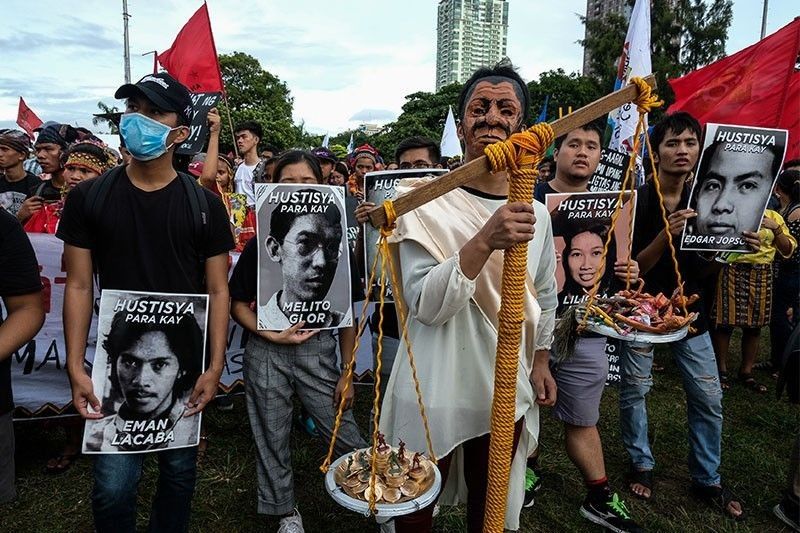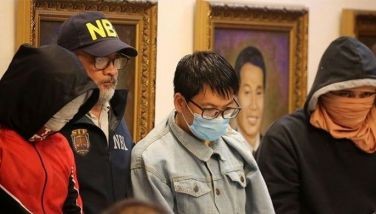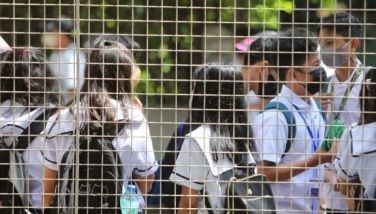How films and art can help protect Martial Law memory from revisionism

MANILA, Philippines — The victims of Martial Law and their families' quest for justice continues more than three decades since the Marcos dictatorship fell, and in 2020, they are called to engage in yet another fight: One against historical revisionism that would erase what they have been through.
While the Philippines continues to grapple with a pandemic, lawmakers at the House of Representatives on September 1 approved on third and final reading a bill declaring September 11 as a special non-working holiday in Ilocos Norte to commemorate the birthday of the late dictator — seen as another move to rehabilitate the Marcos name.
Sen. Imee Marcos earlier this year also attempted to push the narrative that "Masagana 99," her father’s pet agriculture project was “effective” and a success at a Senate hearing but she was promptly corrected by Finance Secretary Carlos Dominguez III, the agriculture secretary who “cleaned up the mess” left by the project.
Faced with facts and research, Sen. Marcos claimed that Dominguez's crtique of the program was him giving up on Filipino farmers."Shame on you, Secretary Dominguez, give the Filipino farmer some credit," she said.
The COVID-19 pandemic has not stopped victims of Martial Law and their families from holding activities to remind the people of the atrocities during that dark period in Philippine history.
Students and activists also held protests and programs at the Commission on Human Rights and the University of the Philippines Diliman. With a pandemic keeping many confined to their homes, webinars on Martial Law were hosted weeklong and Daang Dokyu and the Cultural Center of the Philippines streamed Martial Law documentaries and films for free.
Forgetful Filipinos?
“Citizen Jake” (2018) one of the recent films that touched on Martial Law was borne from the idea of director Mike De Leon who noted an "inability of the Filipino people to learn our lessons from history,” shares film writer Noel Pascual.
Prior to the conception of “Citizen Jake,” De Leon had been releasing short films on social media on the possibility of another Marcos presidency.
De Leon is no stranger to films on set in the Martial Law period, having directed and written "Batch ’81" (1982) and "Sister Stella L " (1984), and his comeback film did not cower from laying down the truths about the dictatorship.
"Citizen Jake" was set in 2015 and featured “citizen journalist” Jake Herrera, the second son of a former Marcos crony gunning for a seat at the Senate. Jake is in dogged pursuit to unfurl the corruption activities of Marcos croniesof the truth behind corruption allegations against Marcos cronies, when a brutal murder of a student yanks him out of his fixation.
In the Philippines in the film, former Martial Law administrator Juan Ponce Enrile is a sitting senator, the dictator’s son and namesake Bongbong isrunning for vice president, daughter Imee is the governor of the Ilocos Norte while matriarch Imelda is a lawmaker at the House of Representatives.
RELATED: Fact-checking Enrile's tete-a-tete with Bongbong Marcos
Pascual says: “There was and is a concerted effort to rehabilitate the Marcos name and to portray the Martial Law days as a kind of golden age in our history even though the facts as well as the actual experiences of our countrymen attest to that regime as being anything but a golden age."
Martial Law films and their political violence
Films on and about Martial Law have one thing in common: They all include scenes of political violence, often brutal.
Asian cultural studies scholar Laurence Marvin Castillo says these allow the viewers to “experience the drama and the brutality of the era by making them identify with those who experience the horrors of the dictatorship onscreen, arousing the individual or collective sense of horror, pity, disgust and rage.”
Sitting through actor Piolo Pascual being electrocuted and sleeping naked on an ice box in the commercially successful and acclaimed film "Dekada ’70", written by the prolific Lualhati Bautista, can make the viewers squirm.
The audience were made to feel the desperation of mother Amanda Bartolome (Vilma Santos) and father Julian (Christopher De Leon) in looking for their missing sons. The ordeal leads to Amanda's political awakening.
"This is also why scenes of political torture, brutality and other forms of political violence are a staple in films about the Martial Law, if only to arouse indignation over the visible inhumanity perpetrated by the dictatorial forces," Castillo says.
Castillo is a PhD candidate at the Asia Institute of the University of Melbourne and a literary and cultural studies professor at the University of the Philippines Los Baños.
Imagined memory
He continues that films about Martial Law “serve as forms of what memory studies scholar Andreas Huyssen calls ‘imagined memory.’”
"These forms of memory allow younger generations who have no first-hand experience of the dictatorship to craft, develop and claim their own memory of the past," he adds.
Films like "Citizen Jake", and dozens of others that touch on Martial Law can counter historical revisionism by showing the atrocities of, and the resistance to, the regime, he adds.
"Films do this through a language that cultivates sensory and affective responses more effectively and urgently than history books or scholarly studies," Castillo continues.
"As such, films are perhaps one of the most effective means to teach history in the public sphere."
Convergence with history
Films, short ones released on YouTube, have also been a powerful tool for revisionists, with some calling themselves "history vloggers" and claiming to disprove documented history on the Martial Law period.
Actual historian Xiao Chua notes in a September 26 column in the Manila Times that history is more than just the repetition of facts, and must be presented in a wider context.
"I believe that a historian doesn’t end with the articulation of facts. The third requirement would be the capacity to analyze and connect those facts to the larger historical narrative. Failure to do this makes one a mere antiquarian. Dapat may saysay," he says in his column, which discusses the requirements to be considered a historian.
The first two requirements, according to Chua, are familiarity with the methodology of historical research and publication in a "refereed journal that was checked by fellow historians."
"Public historians, like myself, will be preoccupied with bringing history closer to the people, which include the perils to mental health of engaging the public and even the trolls and haters in every controversial topic such as Emilio Aguinaldo and Ferdinand Marcos. To proliferate the importance of public history is a way for history to really remain relevant, may saysay, to our people," he also says.
In a September 19 webcast on social media portal Now You Know, Chua also stresses that torture and abuse during the Martial Law period has been well documented. "These abuses by the military and police and the agents of the dictatorship were systematic. These were not the actions of individual people who wanted to abuse their power." he says in Filipino.
He adds that while the abuses were documented and are supported by testimonies from victims, the actual extent of these cases could be much more than what is known because many of the victims may have been too afraid to come forward.
Chua acknowledges that Marcos invested a lot in infrastructure projects "because he was conscious of history" and knew that it would be the architecture and the infrastructure that would remain and be remembered but stresses that these were built amid a climate where dissenters were arrested, tortured, and disappeared.
Art as resistance
Concerned Artists of the Philippines, through spokesperson Lisa Ito, says films can help counter historical revisionism by “testifying to the realities that the Filipino people endured under the dictatorship.”
CAP is an organization of writers, artists and cultural workers committed to the principles of freedom, justice and democracy. It was founded in 1983 to unite Filipino artists against the Marcos dictatorial regime, according to its site.
"Art can distill memories, lived experiences, and narratives of hardship and struggle into compelling stories and powerful images that stand the test of time. No amount of whitewashing and lies can erase that," she says.
Ito points out that some songs, illustrations, crafts and paintings that came out at the time were produced by political detainees during Martial Law. "These were birthed and used for the many militant actions of the day or wielded as powerful statements against the system." she adds.
RELATED: There is more to graffiti than 'making a mess,' activists say
AFP links Martial Law films to supposed 'Red October' plot in 2018
In 2018, showing of Martial Law films caught the attention of the Philippine military and they sought to block screenings at the University of the Philippines.
Brig. Gen. Antonio Parlade Jr. claimed that these films were linked to a supposed “Red October” plot — a supposed conspiracy between communist rebels, the pro-military Magdalo group and the Liberal Party, a traditional political party — they floated and that didn't materialize.
Parlade said Martial Law films were being used to “incite students to rebel against the government, incite resurgence of the First Quarter Storm experience among students, while projecting President Duterte as the new Marcos.”
Castillo, in his essay published in the Newsletter of the International Institute of Asian Studies, says that the military’s linking of Martial Law films to communism "shows how the state cultivates ‘authoritarian nostalgia.’'
"The specter of the communist revolution is brought up to whitewash the atrocities of the earlier authoritarian order, and more disturbingly, to justify the return of dictatorial rule, this time under the presidency of Rodrigo Duterte," he continues.
Castillo says that films on Martial Law, which continues to expand over the years to include independent films such as "Barber’s Tales" (2013) and "Liway" (2018), prove their potential to not only “memorialize the violence of a dictatorship” but also “make use of the power of fiction cinema to examine the relevance and persistence of the revolutionary vision, especially in light of contemporary concerns such as identity politics.”
"They produce fictionalized versions of the radical past that are significantly shaped by, while dialoguing with, the socio-political sensibilities of the present. And indeed it is the current nominally democratic order’s shared features with, and gradual transition to, authoritarian rule that urgently demand the surfacing of such radical memory practices," he adds.
Continuing history, contemporary struggles
“Citizen Jake” writer Pascual says that they hope the younger generation that saw their film would have been made aware of how the country was during Martial Law.
He notes that the film also points out how the atrocities during Martial Law still haunt the Philippines to this day, “through the massive inequality and corruption entrenched in our systems.
“I hope that 'Citizen Jake' and other similar films also have the effect of encouraging the youth to recognize and fight against these current-day evils in our society,” he adds.
Under the administration of President Rodrigo Duterte, deaths in the brutal 'drug war' continue to pile up—pandemic notwithstanding—and a highly contested anti-terrorism law, flagged by law experts and human rights advocates for its “chilling effect” was enacted.
For CAP’s Ito, making art is an important response to current realities in the Philippines. Artists under their network continue to memorialize contemporary history, such as the victims of the 'drug war' and killings of human rights workers and activists in the current administration.
Sa linggong ito, pinalaya ni Duterte si Pemberton. Samantala ang mga lumalaban para sa mga karapatan ng masang api at...
Posted by Concerned Artists of the Philippines on Thursday, September 10, 2020
Works created “within, and for, the people’s ongoing struggle for sovereignty, land, rights, health, jobs, and good governance” capture the realities and problems, serve as markers for historical events, and chronicle how people respond to them," she says.
"In doing so, it goes beyond being a window to the past: it becomes a part of the continuing struggle today," Ito adds.
Castillo stresses that artists and cultural workers make their audience imagine history.
"This imaginative work is important in shaping up how we perceive, react to and act in, society: the work of art as a form of resistance to political violence and repression is even more urgent, given that historically, art has also been used by the dictatorship to whitewash its atrocities," he says.
- Latest
- Trending
































